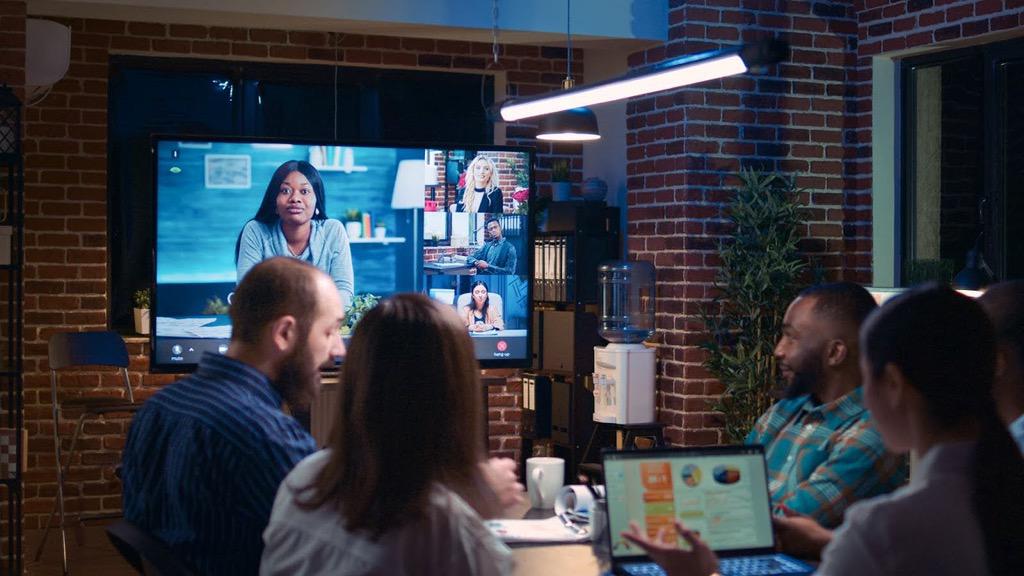Summary:
- Successful hybrid workers are usually adaptable, comfortable working independently and collaboratively, growth-oriented, and excited by challenges.
- These employees seek flexibility, technology integration, and work-life balance. Companies should offer flexible schedules, access to the latest technology, and workplace cultures that hold space for personal pursuits.
- Younger employees value purpose-driven work, career development opportunities, and a tech-savvy culture. Emphasizing these aspects can help attract and retain them.
- Essential technologies for hybrid workplaces include collaboration software, video conferencing systems, desk hoteling platforms, and robust IT support to ensure seamless operations. These tools help distributed workforces remain connected and allow them to collaborate in real time without unnecessary delays.
- ET Group creates and implements custom solutions for hybrid workplaces. This kind of technology consulting can be instrumental in helping organizations invest efficiently in the tools that support distributed teams.
How to Attract & Retain a Hybrid or Distributed Workforce
Hybrid teams have unique needs, so it follows that the people who thrive in hybrid workforces also have unique skills and expectations. Understanding the type of talent best suited for distributed teams is the key to attracting and retaining these individuals for your organization.
At ET Group, we specialize in optimizing for hybrid work—including the spaces, technology, and culture that are essential to these environments. Read on as we show you how to seek out, recruit, and retain the people you’ll need to help your modern workforce succeed.
Who Thrives in a Hybrid Work Environment?
Hybrid work environments require a particular set of skills and characteristics for individuals to excel. Recognizing these traits can help you identify the right candidates for your team.
Key Characteristics
Hybrid workers must be:
- Adaptable enough to switch quickly and seamlessly between tasks and environments.
- Comfortable working both independently and collaboratively.
- Growth-oriented and eager to learn new skills—this increases technology adoption.
- Excited by challenges, which helps with embracing and optimizing the new processes that come with a distributed work environment.
Common Expectations
Individuals who excel in hybrid spaces often seek out workplaces that offer the following:
Flexibility
One of the main draws of hybrid work is the ability to work from various locations and at different times. Employees who value and expect this flexibility are more likely to be satisfied and productive in a hybrid role.
Tip: Offering flexible schedules and remote work options can attract top talent who prioritize work-life balance.
Technology Integration
Successful hybrid employees often look for workplaces that successfully integrate leading digital tools and platforms.
Tip: Ensuring your team has access to the latest technology and is proficient in its use can significantly enhance productivity and communication.
Learn More: Audio Visual Technology Adoption Starts with Better End User Training
Work-Life Balance
Many of the people who excel in hybrid environments prioritize a harmonious balance between their professional and personal lives. Companies that promote a healthy work-life balance are often the most successful at retaining these employees.
Tip: Offer resources such as mental health support, flexible hours, and remote work options. You should also consider what you’ll need to do to make your hybrid workplace a desirable place for employees.
Learn More: Encourage Employees to Come Into Work by Making the Office More Useful
Special Considerations for Millennials & Gen-Z Employees
Millennials and Gen-Z employees bring a fresh perspective to the workforce—and they often have specific preferences as well. Understanding these can help you attract and retain younger talent.
Purpose-Driven Work
Younger employees tend to seek meaningful work that aligns with their values. Emphasizing your company’s mission, social responsibility, and impact can make your organization more attractive to them.
Career Development
Millennials and Gen-Zs value opportunities for growth and development. Offering clear career progression paths, professional development programs, and mentorship opportunities can help retain these employees.
Tech-Savvy Culture
Growing up with technology, younger generations expect seamless integration of digital tools in their work environment. Providing cutting-edge technology and fostering a culture of innovation can make your company more appealing to them.
Learn More: Making Hybrid Happen: Six Principles for Technology Integration
Leveraging Technology to Meet These Needs
Now that you have some direction about the types of candidates to focus on when building a distributed workforce, it’s time to think about the specific technologies that you’ll use to support and retain them. Here are a few essentials for hybrid workplaces:
Collaboration Software
Numerous different tools exist that can help distributed teams collaborate in real-time—from relatively simple examples like Google Docs to sophisticated virtual whiteboarding programs that let teams brainstorm, plan, and visualize projects together in real-time to bridge gaps between remote and in-office staff.
Examples:
- Miro: An online collaborative whiteboard platform that enables distributed teams to work together visually and brainstorm, plan, and collaborate in real time.
- Microsoft Whiteboard: A digital whiteboard app from Microsoft that allows teams to ideate, create, and collaborate visually across devices.
Video Conferencing Systems
These systems support high-quality video and audio, offer features such as screen sharing and virtual backgrounds, and are often compatible with other collaborative software. Ensuring these tools are user-friendly and easily accessible helps maintain strong team connections and facilitate efficient meetings.
Examples:
Popular software for video conferencing includes:
- WebEx: A video conferencing and online meeting software from Cisco that offers various features for remote communication and collaboration.
- Zoom: A video conferencing tool that focuses on ease of use and reliability, offering features like video meetings, webinars, and screen sharing.
- Microsoft Teams: A collaboration platform from Microsoft that combines chat, video meetings, file storage, and app integration to support teamwork.
Desk Hoteling Platforms
Desk hoteling allows employees to reserve desks or workspaces when they plan to work on-site. This flexibility supports the hybrid model by providing a structured yet adaptable office environment. It also improves the utilization of office space, which can help hybrid workplaces reduce unnecessary costs.
Examples:
- Robin: A platform that helps companies manage their office space and resources, including desk booking and meeting room scheduling.
- OfficeSpace: A comprehensive workplace management software that includes features for desk booking, space management, and facilities management.
Robust IT Support
Robust IT support is the backbone of a successful hybrid work environment. This includes not only responsive and efficient technical support but also the implementation of remote workplace analytics.
ET Group’s workplace insights provide actionable data to hybrid workplaces about when and how their technology is being used. This information can be used to:
- Invest more efficiently in the space and technology upgrades team members will actually use.
- Reduce unnecessary costs by identifying and eliminating redundancies in the technology stack.
- Learn about the needs of your team and ensure they can take adequate breaks between meetings.
- Proactively identify and troubleshoot technical issues to minimize disruptions during meetings or projects.
Learn More: 5 Reasons to Optimize Your Business Meeting Space with Workplace Analytics
Build the Right Hybrid Team for the Ideal Hybrid Workplace
Successful hybrid work requires harmony between people and technology. Use what you’ve learned above to refine your approach to recruitment so you can attract personnel who will actively thrive in a hybrid space—then work with us to ensure that your spaces and technology empower them to work happily and effectively.
ET Group creates custom hybrid workplace solutions for organizations of all kinds. Book a discovery call with us below and find out how we can help you bring your workplace into the modern era.
Stay connected with us:
Follow ET Group on LinkedIn
Subscribe to ET Group’s YouTube Channel










